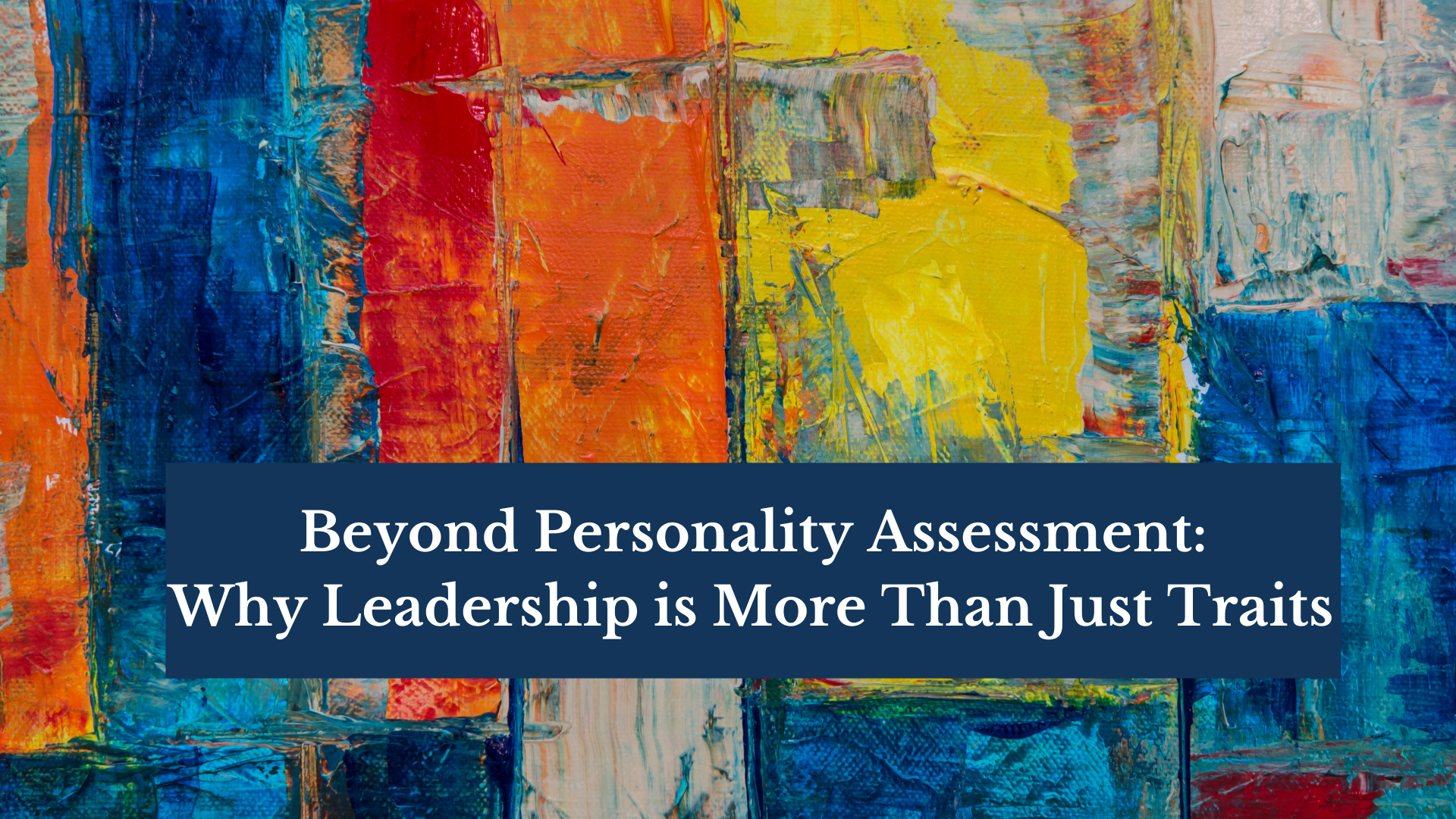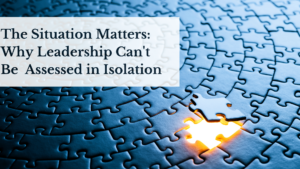Personality and Leadership
Personality questionnaires (PQs) are a trusted staple in leadership assessment. For years, they’ve been part of the toolkit for evaluating leaders for development or selection (Bass & Bass, 2008). From Big Five tests to Type Indicators, PQs promise to reveal key traits that shape how a leader might behave. But here’s the problem: PQs measure tendencies, not outcomes. They tell us what a person might do, not what they actually do in a leadership role. They don’t account for the complexities of leading teams at different levels, adapting to specific challenges, or delivering real-world results.
Given the importance of good leadership in an organisation, why are we relying on personality?
At some stage, your personality has probably been assessed – whether for your own development at work or as part of a recruitment process. Perhaps, as a manager, you’ve initiated the use of PQs as part of a development program or to help you make a hiring decision. For development or selection, the logic of using PQs seems to make sense.
If we’re developing leaders, we might use PQs to enhance self-awareness – a building block of emotional intelligence, which is believed to underpin leadership performance (Bratton et al., 2011; Cherniss, 2010).
Meanwhile, in selection, PQs are used to help predict how an individual might behave as a leader, helping identify the best-fit candidate for the role (Salgado & de Fruyt, 2017). For example, someone scoring high on ‘extraversion’ might be expected to be charismatic and engaging as a leader, while high scores on ‘conscientiousness’ might indicate an individual who brings discipline and goal focus to their leadership.
The logic appears sound. But do we have data to support it? And from a practitioner’s point of view, do PQs genuinely predict leadership effectiveness?
The Gap Between Personality and Leadership Performance
Research shows that personality does indeed have some connection to leadership. Though published over 20 years ago, the classic research article by Judge et al. (2002) remains highly influential, having been cited in nearly 6,000 publications. They conducted a meta-analysis, combining the results of 222 studies on personality and leadership to identify overall trends and statistical relationships.
In their analysis, Judge et al. distinguished between leadership emergence and leadership effectiveness.
Leadership emergence is about how someone naturally becomes a leader within a group. Imagine a team with no assigned leader, for example, during a group discussion at a candidate assessment centre. Over a short period, one or several individuals will step up, take charge, and gain influence. Emergence is about becoming the leader.
In contrast, leadership effectiveness is about being the leader in the workplace: making good decisions, motivating people, and driving success in the team over time.
So, what did the meta-analysis find? Across studies, the two strongest relationships with leadership were with the personality dimensions of extraversion (r = .31) and conscientiousness (r = .28). Though statistically significant, both correlations were relatively low and were primarily linked to leader emergence rather than leadership effectiveness. Openness to experience (r = .28) and neuroticism (negative correlation, r = -.24) showed even smaller relationships, while agreeableness – often associated with being cooperative and socially warm – was largely unrelated (r = .08).
What does this mean? Clearly, personality has some predictive power, but it leaves the majority of leadership effectiveness unexplained.
Don’t get me wrong, I’m still a strong supporter of personality assessment when it’s used in the right context. In particular, research on the Five Factor Model has been shown to be highly robust (Barrick & Mount, 1991) and applicable across cultures (McCrae & Allik, 2002). However, when it comes to selecting individuals for leadership roles or developing leaders to be more effective, PQs add limited value – and their role is often overplayed. Here’s why.
Leadership Is Highly Contextual
Since the 1960s, we’ve known that context is vital to leadership research (Fielder, 1967), yet it is frequently ignored. Leadership isn’t just about behaviour, and it’s certainly not just about the leader. Critically, leadership is about delivering results through people in a specific situation.
A leader who thrives in a fast-growing tech start-up may struggle if moved to a bureaucratic corporate environment. Leadership effectiveness is shaped by industry, company culture, team dynamics, and situational challenges – none of which are captured by PQs.
Personality Assessment Is a Weak Proxy for Assessing Leadership
There’s a convenience and scalability to using personality assessment, particularly if it’s already licenced for use in the organisation. It’s easier than, say, gathering objective data about how someone actually behaves as a leader and the results their team produces. And while personality does have some influence on behaviour, that’s a long way from saying that a PQ can tell you how a leader is performing – or how well they might lead in the future. Of course, PQs were not designed for this purpose, but sometimes they end up being part of the methodology that is attempting to do just this.
Why use a weak proxy when more suitable measures could give you a much more accurate reading?
Personality Overlooks the Role of Development and Experience
Leadership is not a fixed trait – it’s a skill that can develop over time. The desire to grow as a leader is key. Many great leaders in business and society didn’t start out as so-called ‘born leaders’ (Bradley-Silverio Donato, 2023). They observed others, experimented with different approaches, reflected, adapted, and grew through opportunities, relationships, and challenges.
PQs don’t account for this growth. They might indicate if you’re open to learning, but not whether you’re actually doing it.
Group-Level Effects Don’t Predict Outcomes for Individuals
Correlations in research studies, especially weak but positive ones (e.g., as found by Judge et al., 2002) indicate general trends across large groups, but they don’t reliably predict outcomes for individuals. This distinction highlights group-level vs. individual-level effects in personality assessment.
At the group level, patterns emerge – certain traits might, on average, be linked to leadership. However, at the individual level, many other factors (such as context, experience, and personal development) can override these general trends.
So, while a study might suggest that extraversion is linked to leadership, an introverted individual could still be an exceptional leader due to other qualities and situational factors.
Leadership Emergence Isn’t Useful in the Real World
There are some weak effects between personality and leadership emergence. But does this really matter? Isn’t leadership effectiveness the gold standard?
Leadership emergence is, of course, far easier to measure than effectiveness. Emergence can be observed in lab-based simulations, such as role plays involving psychology students at university – a convenient basis for research studies, but with questionable validity for the workplace (Schacter et al., 2019). In contrast, assessing leadership effectiveness requires observing leaders and their outcomes in organisations, where it is much harder to gather reliable data in sufficient numbers for an empirical study.
But to organisations, effectiveness matters – because it’s about getting results. It’s the reason we employ leaders. In contrast, emergence is only of short-term interest if it suggests who the future leaders might be – but it says little about whether or not they will be effective.
In essence, we should be measuring leadership outcomes and how leaders enable their teams to work together to produce them. PQs can’t do this – and nor were they designed to.
A Better Way: Measuring Leadership Development Instead of Traits
So, if personality isn’t the best way to assess leadership, what is?
One alternative approach, which emphasises factors beyond personality, was demonstrated in a study by Strang and Kuhnert (2009). They assessed leaders on a construct called Leadership Development Level, which concerned thinking, reflecting, and making decisions – what we might call a leader’s cognitive and behavioural maturity. . They also assessed the same leaders on the Big Five personality dimensions.
Their study found that leadership effectiveness was predicted far more strongly by cognitive and behavioural maturity than by personality. Indeed, personality added very little predictive power.
Measuring how leaders think, adapt, and develop are better indicators of leadership effectiveness than personality traits. These are all skills that can be developed and they might be valuable areas to assess in leadership development programmes. They could also serve as meaningful criteria in selection processes.
But why stop there? Instead of looking for proxies or predictors, why don’t we just measure leadership effectiveness directly? The skills required to lead people have been consistently demonstrated by peer-reviewed research. Instead of using PQs or other predictors, why not go straight to the source and measure the leadership skills and the results they deliver?
What’s Your View?
- If you’ve taken a PQ for leadership, how well did it measure your ability to deliver as a leader?
- Have you found PQs useful in your personal development as a leader?
- What assessment methods have you found are the best measures of leadership?
Share your thoughts in the comments and to find out more about Leadership Cubed visit www.leadershipcubed.io
References
Barrick, M. K., & Mount, M. R. (1991). The big five personality dimensions and job performance: A meta-analysis. Personnel psychology, 44, 1−26.
Bass, B.M. & Bass, R. (2008). The Bass handbook of leadership: Theory, research, and managerial applications. 4th edn. New York: Free Press.
Bradley-Silverio Donato, J. (October 18, 2023). Leadership: a journey of growth, not a stamp of birthright. Forbes Business Council
Bratton, V.K., Dodd, N.G. & Brown, F.W. (2011). The impact of emotional intelligence on accuracy of self‐awareness and leadership performance. Leadership & Organization Development Journal, 32(2), pp.127-149.
Cherniss, C. (2010). Emotional intelligence: toward clarification of a concept. Industrial and Organizational Psychology, 3(2), pp.110-126.
Fiedler, F.E. (1967). A theory of leadership effectiveness. New York: McGraw-Hill.
Judge, T.A., Bono, J.E., Ilies, R. & Gerhardt, M.W. (2002). Personality and leadership: a qualitative and quantitative review. Journal of applied psychology, 87(4), p.765.
McCrae, R.R. & Allik, I. (eds.) (2002). The five-factor model of personality across cultures. Springer.
Salgado, J.F. & de Fruyt, F. (2017). ‘Personality in personnel selection’ in Evers, A., Anderson, N. & Smit-Voskuijl, O. (eds.) The Blackwell handbook of personnel selection. John Wiley & Sons, pp.174-198.
Schacter, D.L., (Author), Gilbert, D.T., Wegner, D.M., & Hood, B. (2019). Psychology (ISE): third European edition. Worth.




